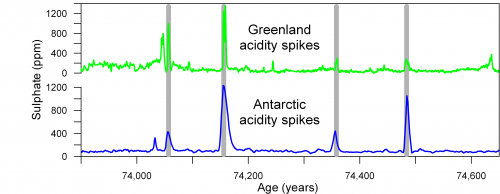Massive volcanic eruption puts past climate and people in perspective

The largest volcanic eruption on Earth in the past millions of years took place in Indonesia 74,000 years ago and researchers from the Niels Bohr Institute can now link the colossal eruption with the global climate and the effects on early humans. The results are published in the scientific journal Climate of the Past.
The volcano Toba is located in Indonesia on the island Sumatra, which lies close to the equator. The colossal eruption, which occurred 74,000 years ago, left a crater that is about 50 km wide. Expelled with the eruption was 2,500 cubic kilometers of lava – equivalent to double the volume of Mount Everest. The eruption was 5,000 times larger than the Mount St. Helens eruption in 1980 in the United States. Toba is the largest volcanic eruption on Earth in the last 2 million years.
The volcanic eruption threw huge clouds of ash and sulphuric acid into the atmosphere and up into the stratosphere, from where it spread across the entire globe in both the northern and southern hemispheres and fell down as acid rain.
Traces of acid rain in the ice caps
"We have now traced this acid rain in the ice caps on Greenland and Antarctica. We have long had an idea of at what depth the Toba eruption could be found in the Greenland ice cap, but we found no ash, so we could not be sure. But now we have found the same series of acid layers from Toba in the Greenland ice sheet and in the ice cap in Antarctica. We have counted the annual layers between acid peaks in ice cores from the two ice caps and it fits together," explains glaciologist Anders Svensson, Centre for Ice and Climate at the Niels Bohr Institute at the University of Copenhagen.
"This means that we can compare the ice cores from Greenland and Antarctica with a annual accuracy and thus combine our knowledge of climate change in the northern and southern hemispheres," emphasizes Anders Svensson.
There has been much speculation about how such a huge eruption affected the climate. The giant clouds of sulphur particles that are thrown up into the stratosphere form a blanket that shields from the sun's radiation and this causes the Earth to cool. But how much and for how long? Modelling has shown that such an enormous eruption could cause a cooling of up to 10 degrees in the global temperature for decades..
"In the temperature curves from the ice cores we can see that there is no general global cooling as a result of the eruption. There is certainly a cooling and large fluctuations in temperature in the northern hemisphere, but it becomes warmer in the southern hemisphere, so the global cooling has been short," says Anders Svensson.
Consequences for man
But the eruption may still have had major consequences for nature, the environment and humans in large areas of Asia, where a clear layer of ash from the eruption has been found.
The eruption occurred at a fateful time in human history, around the time when there was a mass exodus of our ancestors, Homo sapiens, from Africa to Asia and researchers believe that early people living as far as 2000 km away in eastern India were affected by the eruption, which raged for weeks.
Archaeologist, however, strongly disagree about what the consequences of the Toba eruption were for people living in the areas of Asia that were affected by the eruption. Speculation ranges from almost no effect to total or partial extermination of the population in large areas. Material from this period is too old to be dated using the carbon-14 method and the Toba ash layer is therefore a very important reference horizon.
"The new precise location of the Toba eruption in the ice cores will place the archaeological finds in a climatic context, which will help to shed light on this critical period of human history," says Anders Svensson.
More information: Climate of the Past: www.clim-past-discuss.net/8/5389/2012/
Journal information: Climate of the Past
Provided by University of Copenhagen




















